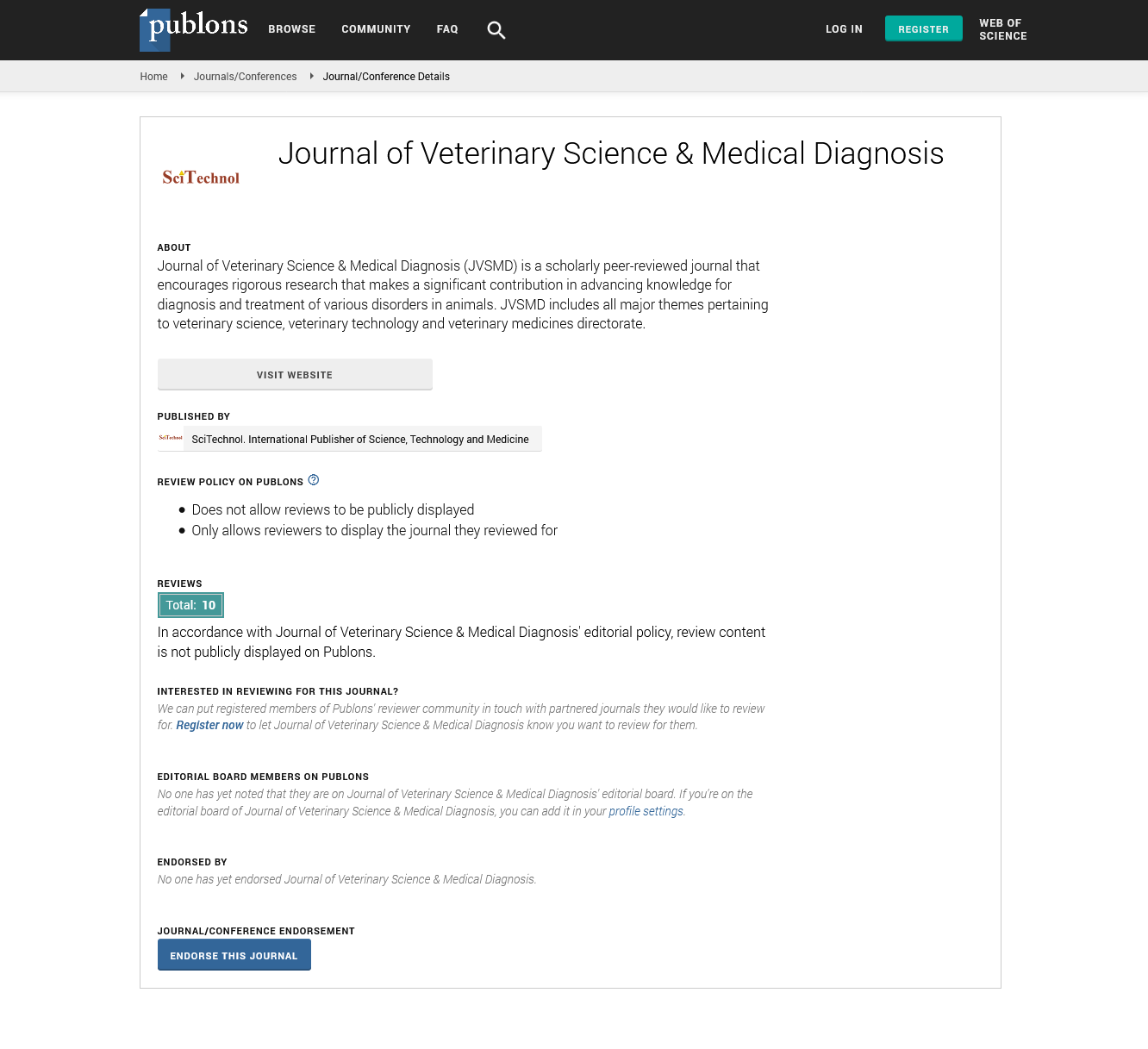Commentary, J Vet Sci Med Diagn Vol: 13 Issue: 4
The Science of Suffering: How Veterinary Pathology Enhances Disease Understanding
Chen Zhang*
1Department of Veterinary Immunology, Northwest Agriculture and Forestry University, Shaanxi Province, China
*Corresponding Author: Chen Zhang,
Department of Veterinary Immunology,
Northwest Agriculture and Forestry University, Shaanxi Province, China
E-mail: zhangch@gmail.com
Received date: 19 June, 2024, Manuscript No. JEEET-24-144723;
Editor assigned date: 21 June, 2024, Pre QC No. JEEET-24-144723 (PQ);
Reviewed date: 5 July, 2024, QC No. JEEET-24-144723;
Revised date: 12 July, 2024, Manuscript No. JEEET-24-144723 (R);
Published date: 19 July, 2024, DOI: 10.4172/2324-83414.1000105
Citation: Zhang C (2024) The Science of Suffering: How Veterinary Pathology Enhances Disease Understanding. J Vet Sci Med Diagn 13:2.
Description
Veterinary pathology plays a difficult role in advancing our understanding of animal diseases by investigating the causes, mechanisms, and effects of various health conditions. Through meticulous examination of tissues and organs, veterinary pathologists provide important insights that enhance diagnosis, treatment, and prevention of diseases in animals. This branch of veterinary medicine bridges the gap between clinical symptoms and underlying disease processes, offering a comprehensive view of health and disease.
Uncovering disease mechanisms
At the core of veterinary pathology is the examination of tissue samples and organ systems to understand the nature and progression of diseases. Pathologists utilize a range of techniques, including histopathology, cytology and autopsy, to study tissue alterations and cellular abnormalities. By analyzing these samples under a microscope, they can identify specific changes associated with various diseases, such as tumors, infections, and inflammatory conditions. Histopathology, for instance, involves staining tissue samples to reveal structural changes that may indicate disease.
This technique allows pathologists to distinguish between benign and malignant tumors, diagnose infections, and identify autoimmune conditions. Cytology, on the other hand, examines individual cells obtained from samples like blood, urine, or bodily fluids, providing information about cell abnormalities and disease processes. Autopsy, or post-mortem examination, is particularly valuable for understanding the full extent of disease and its impact on the body. It helps pathologists identify causes of death, determine disease progression, and evaluate the effectiveness of treatment strategies. These insights are important for improving diagnostic accuracy and developing targeted treatments.
Advancing diagnostic precision and treatment
Veterinary pathology enhances diagnostic precision by providing detailed information that guides clinical decision-making. Accurate diagnosis is essential for selecting appropriate treatment plans and managing animal health effectively. Pathologists work closely with veterinarians to interpret laboratory findings and correlate them with clinical symptoms. This collaboration ensures that diagnoses are based on comprehensive data, leading to more informed and effective treatment strategies. Recent advancements in veterinary pathology have further refined diagnostic capabilities.
Techniques such as molecular pathology and immunohistochemistry have revolutionized the field by allowing pathologists to detect specific genetic mutations and protein expressions associated with various diseases. Molecular pathology, for example, involves analyzing DNA, RNA, and proteins to identify genetic disorders and cancer biomarkers. Immunohistochemistry uses antibodies to detect specific proteins in tissue samples, aiding in the diagnosis of diseases like lymphoma and infectious diseases. These innovations not only improve diagnostic accuracy but also contribute to personalized medicine. By understanding the unique characteristics of an animal's disease at the molecular level, veterinarians can tailor treatments to the specific needs of the individual. This approach enhances the effectiveness of therapies and minimizes adverse effects, leading to better outcomes and improved quality of life for animals.
Enhancing disease prevention and public health
Veterinary pathology also plays a vital role in disease prevention and public health. By studying the pathology of zoonotic diseases those that can be transmitted from animals to humans pathologists help identify risk factors and develop strategies to prevent disease spread. For example, understanding the pathology of diseases like rabies, leptospirosis, and West Nile virus informs vaccination programs, public health interventions, and biosecurity measures. In addition, veterinary pathology contributes to the monitoring and management of emerging diseases.
As new pathogens and disease outbreaks occur, pathologists analyze the disease mechanisms and transmission patterns, providing valuable data to guide public health responses and control measures. In conclusion, veterinary pathology is essential for deepening our understanding of animal diseases, improving diagnostic accuracy, and advancing treatment strategies. By examining tissue samples and studying disease mechanisms, pathologists provide difficult insights that enhance both individual animal care and public health efforts. Through their work, veterinary pathologists help mitigate suffering, optimize treatment outcomes, and contribute to the overall well-being of animals and humans alike.
 Spanish
Spanish  Chinese
Chinese  Russian
Russian  German
German  French
French  Japanese
Japanese  Portuguese
Portuguese  Hindi
Hindi 
